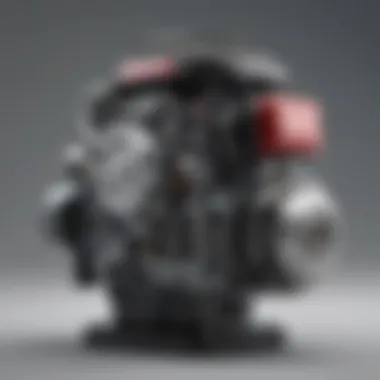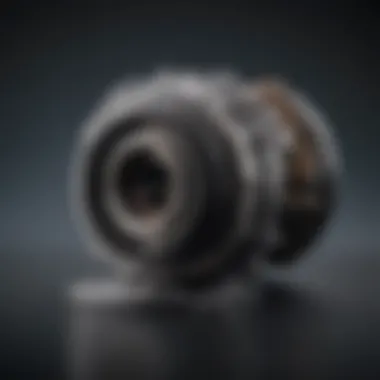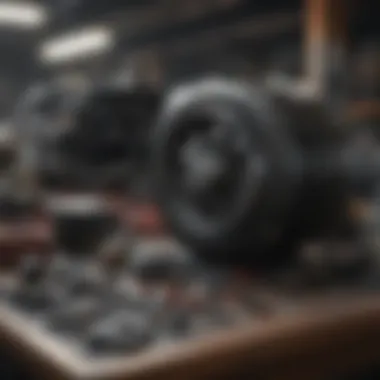Understanding Nissan Boat Motor Parts Explained


Intro
Nissan boat motors are crucial for a smooth sailing experience. Every part in these motors plays its own role, contributing to performance, durability, and overall reliability. Understanding these components not only aids in maintenance but also enhances the ability to make sound purchasing decisions. It's not just about horsepower or speed; it's about knowing what makes a motor tick and how to optimize its function.
In this guide, we'll navigate through the various elements that compose Nissan boat motors, shedding light on everything from basic maintenance practices to choosing between original equipment manufacturer (OEM) parts and aftermarket alternatives. Whether you're a seasoned boater or a newcomer, this examination aims to empower you with knowledge, turning you into a more informed consumer.
Let's cast off into the details, beginning with the current state of the market, which will set the stage for understanding how various factors come into play regarding these vital systems.
Prelims to Nissan Boat Motors
Understanding the intricacies of Nissan boat motors is not just for the enthusiasts who love the thrill of the waves; it’s also for the practical-minded buyer who wants to make informed decisions. This section sets the stage for a deeper exploration into the world of boat motors, tackling key elements, their significance, and what to consider when diving into this subject.
The essence of a boat motor lies in its ability to convert mechanical energy into motion, steering the vessel across water. Nissan has carved a niche in this arena, offering reliability and efficiency that many boaters have come to trust. Before you throw caution to the wind and invest in one, it’s crucial to understand where these machines came from and the various types that exists.
By examining the history and types of Nissan boat motors, readers can glean valuable insights. What has evolved over the years? What features set different types apart? These questions serve as a compass guiding us through the waters of this complex topic.
Historical Context
Nissan's journey into the marine engine market began long before they became the household name we recognize today. Established in the 1930s, the company initially focused on automotive engines but soon recognized the demand for marine applications. Over the decades, Nissan invested in research and development, leading to innovations that have consistently pushed the envelope. They transitioned from heavier, less efficient models to lighter, more powerful designs that cater to the diverse needs of boaters.
This evolution was not without its challenges. Early models faced competition from more established brands. However, Nissan's commitment to quality and durability soon began to pay off. They carved a niche in the outboard motor market with standout features such as lower emissions and enhanced fuel efficiency, responding to the growing environmental concerns. The historical context not only illustrates Nissan's resilience but also informs today's consumers about reliability and performance.
Overview of Motor Types
Now that we've laid the groundwork, let's shift gears to the types of Nissan boat motors available today. Different motors serve distinct purposes and environments, so selecting the right one depends on your specific needs. In the Nissan lineup, you can generally categorize motors into two types:
- Two-Stroke Motors
- Four-Stroke Motors
- Lightweight and simpler in design
- Often provide a higher power-to-weight ratio,
- Require a mix of oil and fuel, making maintenance a tad tricky.
- More fuel-efficient and quieter than their two-stroke counterparts
- Beneficial for longer runs as they offer better fuel economy
- Require less frequent maintenance compared to two-stroke,
- Often touted for their reduced emissions.
In addition to these, some advanced models feature technologies such as EFI (Electronic Fuel Injection) to optimize fuel consumption and performance.
"Performance is key, but understanding the suitability of your motor type for your specific boating activities is what really makes a difference."
As you can see, knowing these various types not only helps in making a purchase but also enhances the overall boating experience. Keep these categories in mind, as we will dive deeper into components and common issues in the following sections.
Key Components of Nissan Boat Motors
Understanding the core elements that make up Nissan boat motors is vital for enthusiasts and owners alike. These components not only ensure functionality but also influence the performance and durability of the motor. Recognizing the significance of each part allows for better maintenance, timely repairs, and enhancing efficiency. Here, we’ll dissect the key components crucial to the operation of Nissan boat motors—namely the engine block, propeller, fuel system, ignition system, and cooling system.
Engine Block
The engine block serves as the heart of the boat motor. It’s the main structure where everything comes together, housing pistons, cylinders, and other essential elements. The construction material, generally aluminum or cast iron, plays a significant role in weight savings and heat dissipation. The engine block's design directly impacts efficiency, power output, and fuel consumption.
When inspecting your Nissan motor, pay close attention to any signs of wear on the engine block. Cracks or erosion can lead to oil leakage or reduced performance. Given how integral this component is, replacing or repairing it can be a hefty investment, yet critical for maintaining motor reliability.
Propeller
The propeller can be likened to the motor's legs; it’s the part that propels the boat through water. Choosing the right propeller affects speed, acceleration, and fuel efficiency. Propellers come in various shapes and sizes, and their pitch and diameter play a cardinal role in how well your boat performs under specific conditions. A prop with a higher pitch can enhance top speed but may decrease acceleration. Conversely, a lower pitch might give you more torque but less speed.
Maintaining your prop is essential. Regular checks for dings, bent blades, or corrosion can prevent performance issues. A well-functioning propeller not only ensures a smooth ride but can also save on fuel expenses, making it a pivotal element of the motor system.
Fuel System
The fuel system is the lifeblood of any motor; it delivers the essential energy needed for operation. In Nissan boat motors, this system typically includes the fuel tank, pump, lines, and filters, all working in unison to deliver fuel efficiently to the engine. It’s crucial to ensure that your fuel system remains clean and free of blockages, as any obstructions can lead to serious performance problems.
One important thing to note is the type of fuel used; some Nissan motors might require premium unleaded gasoline while others can operate effectively on regular. Knowledge of your specific model’s requirements will safeguard against potential issues stemming from improper fuel selection. Small maintenance practices like replacing fuel filters periodically can make a big difference in overall efficiency.
Ignition System
A reliable ignition system is essential for starting the engine and ensuring that it runs smoothly. This system involves spark plugs, coils, and wiring—all of which work together to create the flame that ignites the fuel-air mixture. Ideally, you’ll want to inspect the ignition system as per the manual's recommendations to ensure optimal performance.
The condition of spark plugs can affect everything from starting the engine to how efficiently it runs. Faulty spark plugs can lead to starting issues and poor fuel economy. Replacing them regularly, as well as checking the ignition coil for wear, can help maintain a seamless operation.
Cooling System
Just like you wouldn’t drive a car without proper cooling, the same applies to boat motors. The cooling system ensures that your engine doesn’t overheat, which can lead to catastrophic failures. Typically, Nissan motors feature either raw water or closed cooling systems.
Regular checks on impellers, hoses, and the thermostat are recommended. Blocked coolers can lead to overheating issues, which are often a headache you don’t want to deal with. Ultimately, keeping the cooling system in check is paramount to extending the life of your motor.
Aftermarket vs. OEM Parts
When it comes to maintaining or upgrading Nissan boat motors, the choice between aftermarket and OEM (Original Equipment Manufacturer) parts stands tall as a significant consideration. This choice can greatly influence not only the performance of your motor but also your overall boating experience. Understanding the nuances of these options will help you make informed decisions that align with your preferences and needs.


Definitions and Differences
At the core, OEM parts are produced by the same manufacturers that created the original components for Nissan boat motors. Simply put, they are like-for-like replacements. These parts come with the assurance of meeting the exact specifications and quality standards set by Nissan. When you opt for OEM, you’re essentially restoring your motor to its original state, which many see as a safe bet for longevity.
On the other hand, aftermarket parts are made by various manufacturers that are not directly affiliated with Nissan. This means they can vary vastly in terms of quality and pricing. Some aftermarket parts may even surpass the original performance while others can miss the mark completely. Thus, when considering aftermarket options, it's crucial to differentiate between reputable brands and lesser-known entities. Not all aftermarket parts are created equal; some may be the proverbial diamond in the rough, while others might just be a way to pinch a few pennies.
Quality Considerations
Quality is a key facet when weighing these options. OEM parts are generally perceived as more reliable because they are engineered to specific, exacting standards. Think of them as the tailored suit of boat motor parts—designed to fit perfectly and perform seamlessly. They often come with warranties, offering peace of mind.
Aftermarket parts, however, present a mixed bag. Some high-quality aftermarket components can provide enhanced performance due to innovative designs or advanced materials. However, you also face the risk of compromised durability or fit. It's essential to do your homework—research customer reviews, consult forums like Reddit, and get recommendations from fellow boat enthusiasts. The right aftermarket choice might yield fantastic results but picking the wrong one can lead you down a frustrating path. Do not overlook this!
Cost Analysis
When balancing your checkbook, the cost difference between OEM and aftermarket parts can be considerable. Generally speaking, OEM parts can be pricier due to their guaranteed quality and fit. They often come with a premium price tag reflecting the branding and assurance of reliability.
Conversely, aftermarket parts tend to be more affordable, making them an attractive option for budget-conscious boaters. However, one must consider the potential hidden costs of using lower-quality components. In the long run, spending less now might inflict more damage down the line—higher repair costs, more frequent replacements, or diminished performance may lead you to spend more overall than if you had chosen high-quality OEM parts from the start.
"While saving a penny may seem like a good idea, it’s the dollar you didn’t spend on quality that can come back to haunt you later."
Ultimately, the decision between aftermarket and OEM parts is influenced by your individual circumstances, budget, and performance expectations. Understanding these aspects can lead to wiser choices that contribute to the longevity and efficiency of your Nissan boat motor.
Maintenance and Care
Keeping a Nissan boat motor in prime condition necessitates regular maintenance and care. Think of it as a fine watch; even the tiniest cog needs attention for everything to tick smoothly. Regular upkeep not only enhances the motor's performance but also extends its lifespan, ultimately saving owners from larger expenses down the road. By being proactive, boat owners can avert headaches and frustrations that arise from unexpected failures at sea.
Routine Inspections
Check Engine Fluids
Checking engine fluids is more than just a mundane chore; it's the lifeblood of your boat motor. Fluids like oil, coolant, and transmission fluids ensure smooth operation and prevent overheating. If these fluids are neglected, it can lead to catastrophic engine problems, making efficient checks a non-negotiable part of routine maintenance.
The key characteristic of this inspection is simplicity. It requires minimal tools—often just a dipstick and a clean rag—to perform effectively. What makes checking fluids so popular is that it is straightforward yet highly beneficial. Unlike more complex repairs, this task can be done quickly and effectively by almost any boat owner. However, if the fluid levels appear lower than expected, it's crucial to understand the potential for leaks and address them promptly.
Inspect Fuel Lines
Fuel lines often play an underappreciated yet vital role in keeping the boat motor running. A simple inspection can save you from long-term issues like fuel leaks, which could turn into costly repairs or safety hazards. This check involves looking for cracks, leaks, and corrosion, as any damage could potentially disrupt the fuel delivery system, resulting in poor engine performance.
The primary benefit of inspecting fuel lines regularly is to catch issues before they escalate. If you ignore a small crack, it could worsen over time. Some parts might need to be replaced every few years, but frequent checks can help in identifying the right timing for such maintenance. While this aspect of upkeep might not require extensive expertise, being attentive can lead to an enhanced understanding of your boat's condition.
Evaluate Electrical Connections
Electrical connections in boat motors are often the unsung heroes of operation. A simple failure in wiring could mean the difference between a smooth start or an abysmal failure to crank up. Evaluating these connections entails checking for signs of wear and tear—like frayed wires or corrosion at battery terminals. This is important to ensure the electrical system runs efficiently and reliably.
One of the key characteristics here is how pivotal these connections are to the performance of a boat motor. A loose or corroded connection can ignite all sorts of performance issues, such as difficulty in starting and power fluctuations. While some might find this task intimidating, it’s often just a matter of visually checking and ensuring everything is snugly connected. Regular evaluation of electrical connections not only fosters reliability but can also make your boating experience more enjoyable by reducing the chances of unexpected problems.
Common Repairs
Repairing your boat motor, while sometimes intimidating, is often necessary to keep on the water longer. Recognizing the most common problems and understanding how to address them will empower owners, saving both time and money.
Replacing the Fuel Filter
Fuel filters are an integral part of the fuel system, and replacing them is essential to ensure that contaminants don’t clog the engine. A common aspect tying into the fuel filter replacement is its accessibility. In most Nissan boat motors, changing the fuel filter can be done relatively simply as it’s often designed for easy access.
What makes it a popular choice among repairs is that it can significantly improve fuel efficiency. A new filter allows optimal fuel flow, which means better performance overall. While it’s typically a straightforward task, it does require diligence; forgetting to replace it can lead to unnecessary strain on the engine and deteriorated performance.
Repairing the Ignition System
When a boat fails to start, the ignition system is often at fault. It encompasses a collection of parts, including the spark plugs, ignition coils, and the ignition switch. Repairing this system is critical, as a functioning ignition is what brings life to your motor.
One key characteristic of addressing ignition issues is its immediate impact on engine responsiveness. If the system is malfunctioning, the boat may crank inconsistently or fail to start entirely. While this repair can be trickier than others, understanding how each piece works can make the job less daunting. Neglecting the ignition can result in frustration during critical boating moments.
Sealing Oil Leaks
Oil leaks are damaging and could potentially lead to a total engine failure if left unchecked. Sealing these leaks is vital not just for performance but also in preventing environmental harm. Regular inspection should include looking for spots of oil under the motor or inspecting the gaskets and seals.
The nature of fixing oil leaks often involves using sealants or replacing damaged gaskets, making it essential to have the right materials on hand. While the task may seem cumbersome, it’s usually a manageable job that can yield immediate benefits, such as improved efficiency and environmental adherence. Failure to address this issue could carry hefty penalties if it leads to pollution.
Keeping your Nissan boat motor in top shape is not just about performance; it’s about responsibility as a boat owner.
Troubleshooting Common Issues
Understanding how to troubleshoot common issues in Nissan boat motors is crucial for anyone looking to maintain optimal performance and extend the lifespan of their equipment. The boat motor is your key to the open waters, and when it starts acting up, it can turn your adventure into a frustrating experience. Knowing how to identify and fix these issues not only saves you time and money but also enhances your understanding of the whole system. Navigate through potential problems effectively and ensure you can get back on the water sooner.
Starting Problems


Starting issues can often be the most alarming, particularly when you're all set for a day on the water. These problems typically stem from two main sources: electrical failures and fuel delivery issues.
Electrical Failures
Electrical failures in boat motors can be ninja-stealthy; they often appear without warning. A key characteristic of these failures is the inability of the engine to crank, which can leave you feeling like you're trying to start a car with a dead battery. This article finds it a beneficial topic because most boaters have faced this dilemma at some point, making it universally relevant. These failures might arise from corroded battery terminals, blown fuses, or faults in wiring. The distinctive feature here is that electrical issues often require some detective work, checking connections, testing voltage levels, and maybe even a multimeter if you're somewhat tech-savvy.
Delayed ignition can lead to added costs if repairs escalate, so zeroing in on the electrical system can prove advantageous. The disadvantage, however, can be the complexity involved in troubleshooting numerous connections and components.
Fuel Delivery Issues
When it comes to fuel delivery, well, this issue can be just as troubling. If the engine isn’t receiving adequate fuel, it won’t start. A classic scenario often involves clogged fuel filters or a malfunctioning fuel pump. The notable characteristic of fuel delivery problems is that they often manifest as sputtering when the engine is running or stalling altogether upon idle. This subject is a hot topic because it pinpoints the importance of clean fuel systems, essential in ensuring that the motor functions as intended.
A unique feature of these issues is that they generally provide clearer indicators than electrical problems. You might smell fuel or even see leaks. The upside is that simpler fixes can sometimes suffice, like changing a filter or tightening a connection, but the downside is the greater risk of engine damage if left unchecked.
Overheating
Jumping on to overheating, it's a significant issue that can quickly lead to severe damage if not addressed. The two culprits often include a clogged cooling system and inadequate lubrication.
Clogged Cooling System
A clogged cooling system can act like a slow drain in your bathtub. Water circulation slows down or even stops, causing your engine to overheat. A key characteristic includes an unexpectedly high temperature gauge or steam rising from the engine compartment. Mentioning this might resonate more with seasoned boaters as overheating can corrode engine parts or even seize the engine. Its critical aspect is that keeping the cooling system free of debris, like rust or seaweed, is paramount.
It’s beneficial to regularly inspect and flush out the cooling system to avoid these problems. However, if neglected, the consequences can be quite costly and lead to extensive engine repairs, making it a classic case of "an ounce of prevention is worth a pound of cure."
Inadequate Lubrication
Inadequate lubrication is another issue that can lead to overheating. If oil levels run low, friction increases, and the engine generates a lot of heat. The key characteristic is typically a drop in oil pressure and a burning oil smell. This aspect is important, as maintaining proper oil levels is straightforward yet often overlooked. The advantages of regular lubrication checks can’t be stressed enough; it could save you from expensive repairs down the line. However, its downside lies in potential engine performance issues that arise from recurrent negligence.
Performance Decline
Finally, performance decline is an umbrella term covering various issues, with acceleration lag and fuel inefficiency being key components to consider.
Acceleration Lag
Experiencing acceleration lag is akin to trying to run in quicksand. The boat might respond sluggishly when you push the throttle. This condition usually stems from stuck throttle cables or even dirty fuel injectors. Its fundamental aspect makes it critical to pinpoint the problem early; otherwise, it can leave you stranded in the water. The key takeaway is that addressing this issue can enhance performance significantly, making it a valuable focus in this article.
The downside is that fixing lag might require a deeper understanding of your engine, which can intimidate less experienced owners.
Fuel Inefficiency
Fuel inefficiency is the thorn in the side of many boaters' budgets. If you're burning through gas faster than a hot knife through butter, you might be dealing with this issue. The telltale sign can come from not achieving the expected distance per gallon, meaning something is off. This problem relates heavily to both engine tune-ups and the quality of fuel being used. It's an important topic because higher efficiency leads to lower running costs and is linked to emissions standards too.
While it offers clear benefits, trying to remedy this situation may not always yield immediate results, since sometimes, addressing multiple factors makes a difference.
Purchasing Nissan Boat Motor Parts
Buying the right parts for your Nissan boat motor is a task that requires careful consideration. It’s not just about grabbing whatever fits; you’d want components that ensure your motor runs smoothly, efficiently, and reliably. With the right parts, the performance of your boat will improve, leading to a better overall experience on the water. But where exactly do you find these parts? And what should you keep in mind while purchasing them? Let’s dive deep.
Where to Buy
Authorized Dealers
Authorized dealers serve as the go-to source for genuine Nissan boat motor parts. Their primary appeal lies in their direct connection to the manufacturer. This means when you buy from authorized dealers, you are getting the real deal, no knock-offs, no fakes.
One key characteristic of authorized dealers is that they often provide expert advice tailored to your specific needs. If you are unsure which part suits your model or any technical specifications, their trained staff can guide you through the options available. Additionally, they usually offer better warranty terms, which adds an extra layer of security when making your purchase.
However, there's one notable disadvantage. The price point of authorized dealers can be steeper compared to other outlets. If your budget is tight, this might make them less appealing. Nonetheless, the assurance of buying quality parts often justifies the expense for many boat enthusiasts.
Online Retailers
On the other hand, online retailers have gained a monumental following due to their convenience and often lower prices. Websites dedicated to marine products offer a plethora of options, sometimes making it easier to find hard-to-locate parts. Most importantly, you can shop from the comfort of your home, often at your own pace.
A key feature of online retailers is the breadth of selection. It's commonplace to find specialized components that might not be readily available in physical stores. Furthermore, many online retailers feature customer reviews that can aid in making a more informed choice based on real user experiences.
That said, the downside of online shopping is the potential for discrepancies in quality. Since you can't see the part up close before buying, there’s always a risk of receiving something that doesn’t meet your expectations. Additionally, the absence of immediate help from sales staff can complicate the purchasing process if you face dilemmas or errors.
Factors to Consider
When diving into the world of boat motor parts, certain factors play pivotal roles in determining your purchase. These aspects are crucial for both performance and compatibility, so it’s worth your while to pay attention.
Compatibility
Compatibility is paramount when selecting parts. A part designed for one model may not fit another, leading to potential performance issues or even motor damage. Every Nissan boat motor comes with specific requirements dictated by its design and engineering.
The standout feature of compatibility is that it enhances your motor’s overall performance. Using parts that align with your motor’s specifications ensures a seamless fit, reducing the likelihood of mechanical failures in the long term. It's a simple but important rule of thumb: if it doesn’t fit, it might not work or could lead to significant problems down the line.


Warranty Policies
Then there’s the aspect of warranty policies, a key consideration often overlooked. A solid warranty can offer peace of mind, giving you confidence that you’re investing in quality.
The beauty of warranty policies lies in their protective nature. If, by chance, the part fails prematurely, a good policy should cover repairs or replacements at no additional cost to you. However, the unique feature of warranty policies is that they can vary widely between authorized dealers and online retailers.
If you ever find yourself in a bind with a defective part, having a comprehensive warranty can save you both time and money. Conversely, if you purchase from a source that doesn’t offer robust warranty terms, you could be left high and dry, facing potentially hefty expenses for repairs.
Remember, being well-informed is your best ally in securing the right parts for your Nissan boat motor.
Enhancing Motor Performance
Enhancing the performance of Nissan boat motors is a crucial part of ensuring that your vessel operates at its best. Optimal motor performance not only leads to better fuel efficiency but also significantly improves handling and reliability on the water. Understanding how to enhance your motor's capabilities is vital for any boat owner seeking to maximize their investment.
There are various ways to improve performance, and two key elements often considered are performance parts and tuning adjustments. Each approach serves its unique purpose, catering to different needs and preferences of boat enthusiasts.
Performance Parts
High-Performance Propellers
High-performance propellers are designed specifically to increase speed and efficiency for your Nissan boat motor. One of their key characteristics is their ability to provide better thrust and maneuverability compared to standard propellers. This can significantly impact how responsive your boat is in the water, allowing for sharper turns and quicker acceleration.
The unique feature of high-performance propellers is their pitched design. They are usually crafted from materials that are more durable and lightweight, which results in reduced drag and increased speed. However, it's worth considering that while these propellers can elevate performance, they may also require more frequent maintenance due to their dynamic running conditions. Thus, they can be seen as a beneficial yet high-maintenance aspect of performance improvement in your boat motor.
Upgraded Fuel Systems
Upgraded fuel systems represent another avenue through which one can amplify motor performance. These systems improve fuel delivery, ensuring that engines run smoothly and effectively. A key characteristic of upgraded fuel systems is their capacity to handle higher fuel flow rates safely, which is essential during demanding situations like high-speed maneuvers.
The unique feature of these systems often includes advanced fuel injectors that provide precise amounts of fuel at the right time. This not only enhances engine performance but also improves overall fuel efficiency, leading to savings in the long run. However, there can be downsides, including the initial investment required for installation and potential compatibility issues with older motor models. Nonetheless, the benefits of upgraded fuel systems often outweigh the disadvantages, especially for those serious about their boat performance.
Tuning and Adjustments
Tuning and adjustments are integral to maintaining and enhancing Nissan boat motor performance. Regular tuning can maximize engine power and efficiency. This may involve calibrating the ignition timing, adjusting the fuel-to-air mixture, or tweaking the throttle response. These minor adjustments can lead to significant improvements in how a motor performs.
In the realm of marine motors, getting the tuning just right can mean the difference between a smooth, enjoyable ride and a frustrating experience on the water. Precision in tuning ensures that every component of the motor is working harmoniously, ultimately delivering an optimal output that satisfies both power and efficiency demands.
"Tuning a boat motor is like fine-tuning a musical instrument; every note must harmonize for the best performance."
With these enhancements—be it through performance parts or tuning—you can ensure that your Nissan boat motor performs at its peak. Each modification should be made with careful consideration of how it will impact the overall operation and maintenance needs of your vessel.
Market Trends in Marine Motors
In recent years, the marine motor industry has seen significant shifts, influenced by technological advancements and a growing awareness of environmental issues. Understanding these trends is crucial for stakeholders at every level, from manufacturers to end-users. Staying abreast of these developments can help inform purchasing decisions, enhance performance and ultimately contribute to longer-lasting motor systems. Here, we focus on two principal aspects: emerging technologies and environmental considerations.
Emerging Technologies
The evolution of marine motors is heavily marked by advancements in technology. Innovations have transformed not just how motors operate, but also the types of motors available in the market. Key elements in this evolution include:
- Electric Propulsion Systems: An increasing number of boaters are considering the switch to electric motors. They offer reduced emissions and quieter operation, appealing to those who enjoy immersing themselves in nature without the noise pollution.
- Smart Technologies: Boats now come equipped with smart monitoring systems that provide real-time data on motor performance, fuel consumption, and even predictive maintenance alerts. This means that problems can potentially be addressed before they escalate, fostering better longevity of the motor.
- Hybrid Solutions: Manufacturers are working on hybrids that combine traditional fuel systems with electric components. These motors aim to reduce the reliance on fuel while retaining the power needed for larger vessels.
"Innovation in marine motors is reshaping how we experience boating, making it cleaner and more efficient than ever."
As technologies emerge, it's important for consumers to assess compatibility with existing systems and to identify which innovations genuinely enhance motor performance vs. those that may be on the market as hype without substantial benefits.
Environmental Considerations
Growing ecological consciousness is reshaping the marine motor landscape. People are becoming more aware of the toll traditional motors take on marine ecosystems, which is leading to a faster shift towards adopting greener alternatives. Key factors influencing this trend include:
- Regulations and Standards: Governments worldwide are instituting stricter regulations regarding emissions for marine motors. This movement is compelling manufacturers to innovate and produce more environmentally friendly options, thus reducing the carbon footprint of boating.
- Sustainable Materials: There's a push towards using recycled and sustainable materials in motor production. This not only reduces waste but also appeals to an audience seeking products that align with their values.
- Awareness Campaigns: Marine conservation groups are working tirelessly to educate boaters on the importance of reducing pollution. These campaigns are proving effective, as more consumers consider environmental impacts when purchasing a motor.
A mindful approach regarding environmental concerns doesn't solely reflect a commitment to the planet; it can also lead to cost savings through fuel efficiency and avoiding regulatory fines. As consumers, it’s vital to navigate these trends intelligently to make informed decisions.
In summary, keeping tabs on market trends in marine motors—ranging from emerging technologies to environmental considerations—can empower buyers to choose better products, improve motor longevity, and diminish their ecological footprint.
Ending and Future Outlook
The conclusion of this comprehensive exploration of Nissan boat motor parts serves a vital purpose. It summarizes the critical insights acquired throughout the article while pointing toward the horizon of advancements in this area. As readers step back from understanding how various components contribute to overall motor performance, they are also invited to consider the trajectory of innovation and sustainability in marine engines.
Summary of Key Points
To encapsulate the key points discussed:
- Diversity of Components: Nissan boat motors consist of various essential parts like the engine block, propeller, and ignition system, each playing a crucial role in functionality.
- Aftermarket vs. OEM: The choice between aftermarket and OEM parts can significantly impact reliability and performance, driving the need for careful evaluation when making purchases.
- Maintenance Importance: Regular inspections and repairs are not mere suggestions but necessities for extending the life of boat motors.
- Common Issues: Understanding common operational problems such as starting difficulties or overheating allows boat owners to be proactive, ensuring smoother experiences on the water.
- Market Trends: Recognizing the continual evolution due to emerging technologies and environmental concerns helps potential buyers remain informed and responsible.
Predictions for the Future
Looking ahead, several interesting trends should be highlighted:
- Sustainability Focus: There will likely be an increase in eco-friendly motor technologies, with manufacturers prioritizing energy efficiency and reduced emissions.
- Smart Technology Integration: The incorporation of IoT and AI could lead to enhanced diagnostic capabilities, allowing for real-time monitoring of motor performance, potentially improving maintenance schedules and mitigating failures before they happen.
- Competitive Aftermarket: As the aftermarket for boat motor parts continues to grow, consumers may see an improved range of options at competitive prices, enhancing accessibility for those seeking budget-conscious solutions.
- Material Advancements: We can expect continued research into advanced materials that are both lightweight and durable, which will not only enhance performance but also improve fuel economy.
"The path toward innovation in marine motors reflects not just technological advancement but a commitment to global sustainability."
In summary, the focus on Nissan boat motor parts should encompass not only the current needs of enthusiasts but also a thoughtful gaze into future possibilities. With the right information and foresight, navigating the selection and maintenance of these motors can lead to much richer experiences on the water.







